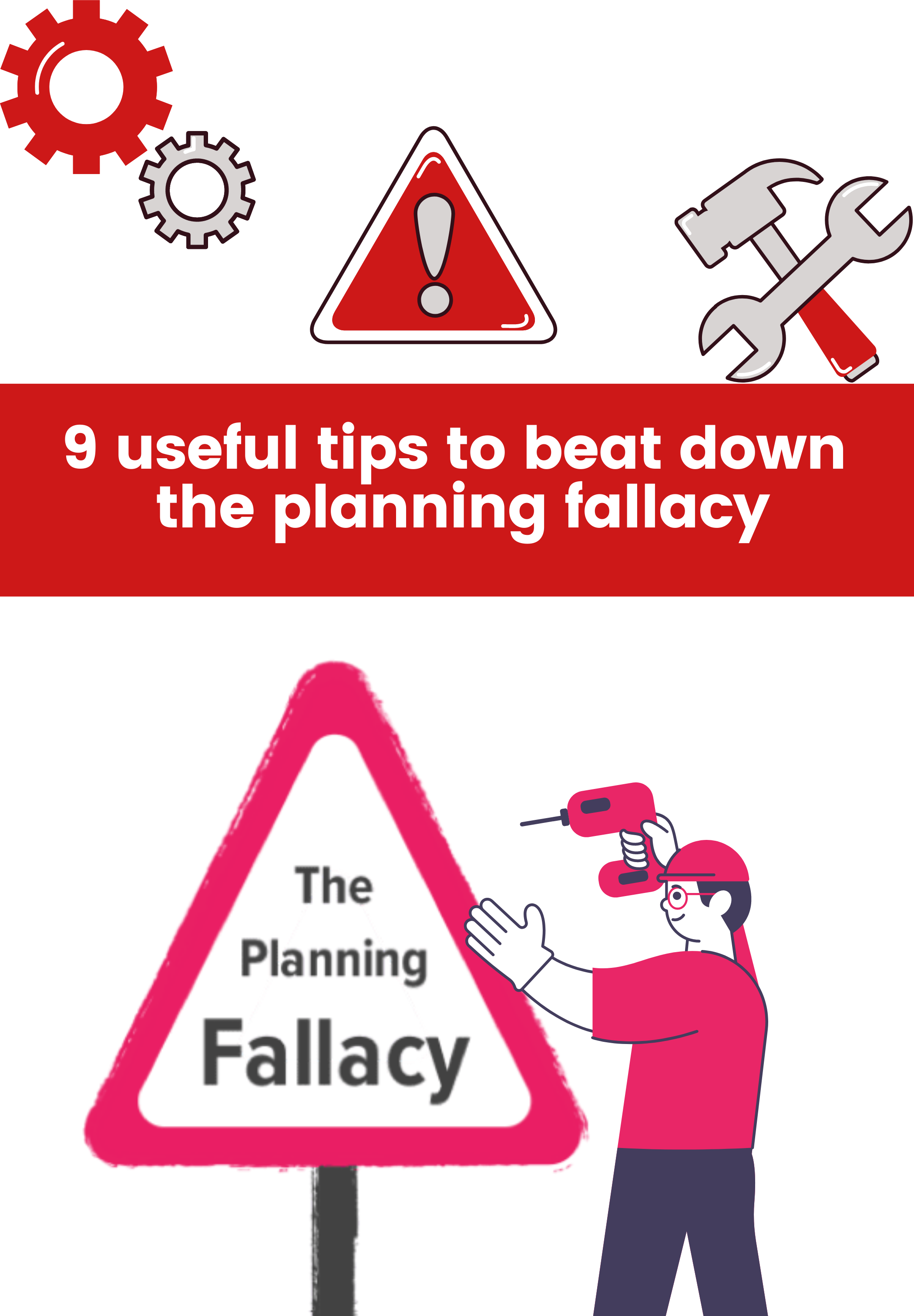9 useful tips to beat down the planning fallacy

Parent Post
The planning fallacy is
The planning fallacy is a prediction phenomenon that states that people underestimate the time it will take them to complete a task.
It was first proposed by Daniel Kahneman and Amos Tversky.
Take an outside viewKahneman
Take an outside view
Kahneman and Tversky believe that people lean towards an “inside view”. They focus on the specifics of the task at hand, paying special attention to its unique features.
Events usually don’t unfold exactly as imagined and you will encounter unexpected obstacles, delays, and interruptions. Try to make more realistic predictions.
Take an “outside view”.
Base your estimates on your prior experiences instead of your frame of reference.
Resist the autocracy of
Resist the autocracy of the urgent
According to Kat Boogaard of Trello, our brains have the not-so-helpful tendency to conflate real, productive work with those other small, menial, and mindless tasks because they provide us a rapid sense of accomplishment.
Phone calls, meetings, tasks with tight deadlines – they want you to take quick action but don’t help advance long-term goals. To solve this vicious cycle, understand the difference between urgent and important tasks. How good you are at distinguishing urgent and important tasks influences your future success.
Let yourself detach from
Let yourself detach from the original plan
Many cognitive biases mess with time management.
Anchoring is another type of cognitive bias. It plays a big role in the planning fallacy. If your original plans are too optimistic, anchoring – the tendency to rely on early information, comes into play.</p
Your initial predictions tend to stick around as long as they can, leading to insufficient adjustments. So focus on the situation at hand and forget what you were thinking first. Focus on the real situation and forget what you were thinking first. It doesn’t matter anymore.
According to scientists in
According to scientists in “An Economic Model of The Planning Fallacy” (2008) –
“Faced with an unpleasant task, people tend both to underestimate the time necessary to complete the task and to postpone working on the task. Thus projects often take inordinately long to complete and people struggle to meet, or even miss, deadlines.”
Consider the effect of
Consider the effect of social pressure
Workplaces are competitive and demand finishing projects at an inhuman pace leading to organizational pressure.
Workers who appear more enthusiastic than their peers in time assessments take the lead. Try to stick with what you think about your timing. Know your planning fallacy, so your dates will be correct. Remember that it’s the outcome that counts.
The planning fallacy can
The planning fallacy can make it difficult for us to complete tasks like being on time for a meeting, filing taxes, getting ready for your plane departure, or meeting the application deadlines for college. This can lead to extreme stress with a lack of productivity and easy burnout.
Here are 9 ways to overcome this cognitive bias.
Break big tasks into
Break big tasks into smaller ones
By breaking a bigger project into smaller tasks, the work is more manageable. People who procrastinate often feel overwhelmed.
The task seems undoable and evokes feelings of frustration. If you set a tighter deadline for each of your tasks, it will inspire you. You are going to find the most productive way to meet those deadlines and get your work done. When you’re done, take a look back and see how you’ve fared. Measure your progress. See if your assessment of the time needed was correct. Learn from your mistakes. Work better, faster, and smarter.
Ask an unbiased party
Ask an unbiased party to gut-check your plan
If you find it hard to detach from your initial estimates then ask someone for their opinion. Pass your timeline assessment to a coworker.
Don’t reveal your predictions. Ask them to give open and honest feedback on it.
Way forward…Falling into the
Way forward…
Falling into the planning fallacy makes you feel overloaded. Recognize and address it before it gets out of hand.
Don’t let it impact your success. Rely on facts, not hopes. Track your progress and keep working. You’ll get over it with time.
Be a pessimistWhat can
Be a pessimist
What can go wrong, will go wrong — states Murphy’s Law.
Your projects won’t run perfectly, even with your best intentions at heart. Approaching planning from a “negative” and risk management standpoint will help curb enthusiasm.
Here is some handy advice to follow:
- Set a realistic deadline and add a little buffer time
- Focus on your lists and only spend time on what’s necessary.
- Consider what could go wrong and think of how you can respond.
Use the Pomodoro techniqueThe
Use the Pomodoro technique
The Pomodoro technique, created by Italian entrepreneur Francesco Cirillo, teaches us to work with time, not against it. It’s about tracking your time to get a more realistic handle on your projects. Especially on how long specific projects and tasks take you.
Work in short, focused bursts of 20/30/40 minutes. Then you give yourself a brief break to recover and start over. This will break down your large complex task into manageable intervals. Once you start a task, you aim to finish it before attending to urgent but unimportant tasks.
Declutter of ‘time bullies’Your
Declutter of ‘time bullies’
Your working time is special. It’s important. Care about it. When you work, your time is for your work. Stick to it. Don’t get suckered into tasks or leisure you don’t have time for.
Say “no” to unwanted cigarette breaks and gossiping with peers. It may be hard sometimes but use your assertive skills. Know how important is the working time for the development of your idea.

